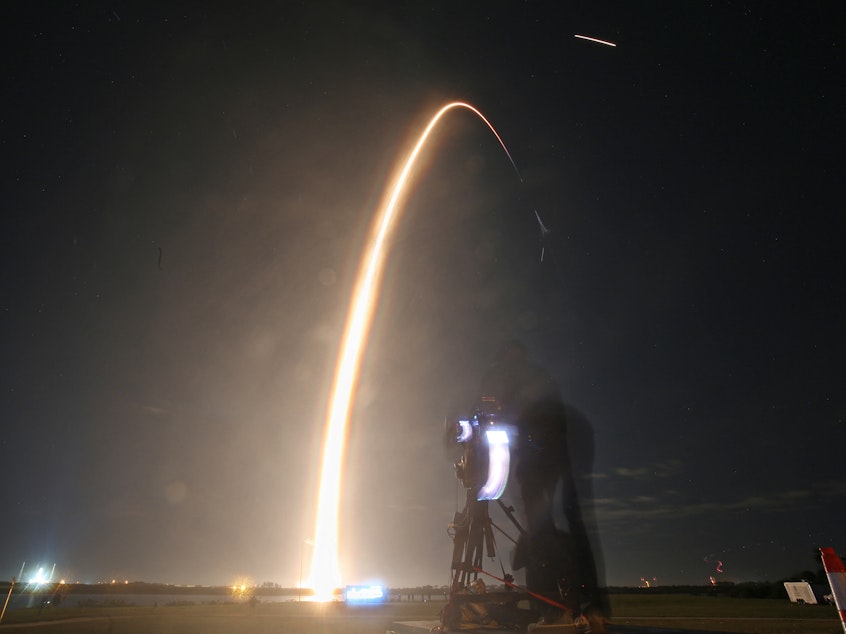Private company Intuitive Machines is set to land on the moon. Here's what to know

The U.S. may be about to land its first commercial mission on the surface of the moon. On Thursday, the robotic probe known as Odysseus is scheduled to set down near the lunar south pole.
But there's still a lot that could go wrong.
The spacecraft was built by the Houston-based company Intuitive Machines. It took off from Florida last week aboard a SpaceX Falcon 9 rocket. The IM-1 mission is one of several that NASA has purchased from private companies as part of its Commercial Lunar Payload Services (CLPS) program.
The space agency is paying a fixed price of a little over $100 million for this mission — a relative bargain when it comes to space exploration. On board are several NASA experiments that will be used to study the environment around the lander and to develop some new technologies for future landings.
Odysseus will attempt to land near Malapert crater — a large crater near the moon's south pole. That location offers several advantages, says Brett Denevi, a planetary scientist at the Johns Hopkins Applied Physics Laboratory. Landing sites near the south pole experience near-continuous sunlight, which can power a spacecraft's solar cells for longer; and some of south pole's dark craters are believed to be home to water in the form of ice.
Sponsored
"Water is important because you can split it apart into hydrogen and oxygen, so you have oxygen to breathe," she says. The two elements are "also components that you can use for rocket fuel."
"The ultimate goal of some of this is to use the moon's resources to enable exploration further out into the solar system," she says.
NASA hopes the CLPS program will help build a network of private suppliers that will allow the United States to once again land astronauts on the lunar surface. It wants commercial companies to scout out locations, land scientific instruments and rovers, and pave the way for human exploration.
But the Odysseus probe also includes several commercial payloads.
"They wanted to facilitate the commercial sector, and you can see that in action on this Intuitive Machines flight," says Chris Quilty, the co-CEO of Quilty Space, which analyzes the space business.
Sponsored
Among the commercial products on board is a space-age fabric from the sportswear manufacturer Columbia, a few pieces of private art and a small test of a system to securely back up data on the moon.
Data "is the most precious asset that we have as a technological civilization," says Chris Stott, founder and CEO of Lonestar Data Holdings, a Florida-based company that wants to build data centers on the lunar surface. "Do we keep it down here where we've got the wars, storms, weather, network intrusion issues ... or do we put it somewhere where there is no climate change? Where there is no atmosphere?"
Stott says his company has already successfully stored and retrieved a digital copy of the Declaration of Independence from the lander. He has future clients, including the state of Florida, looking to store several terabytes of data on the moon in a future mission.
But before NASA can realize its ambitions and before your pictures can be backed up on a lunar hard drive, Odysseus has to stick the landing. And that's not a given. Privately funded lunar missions from Israel and Japan have both crashed in recent years, and another NASA-backed mission from the company Astrobotic fell back to Earth in January after suffering a fuel leak.
"We could really use Neil Armstrong at this point, right?" Quilty quips.
Sponsored
Even though Armstrong and others landed perfectly on the moon in the 1960s and 1970s, lunar landings are still tough, according to Jonathan McDowell, an astronomer with the Smithsonian Astrophysical Observatory who closely follows spaceflight.
"We feel like it's a solved problem, but it's really still cutting-edge," McDowell says.
Robotic missions like Odysseus must automatically fly themselves down to the surface — they can't use parachutes because there's no air there. McDowell says Odysseus could very well crash, like many landers before it, but he says companies are learning from each mistake.
"Even when they fail, they're not failing ignominiously," he says. "With a certain amount of iteration and a few more tries, I'm confident that they can succeed."
The landing is scheduled for 5:30 p.m. ET on Thursday. [Copyright 2024 NPR]


